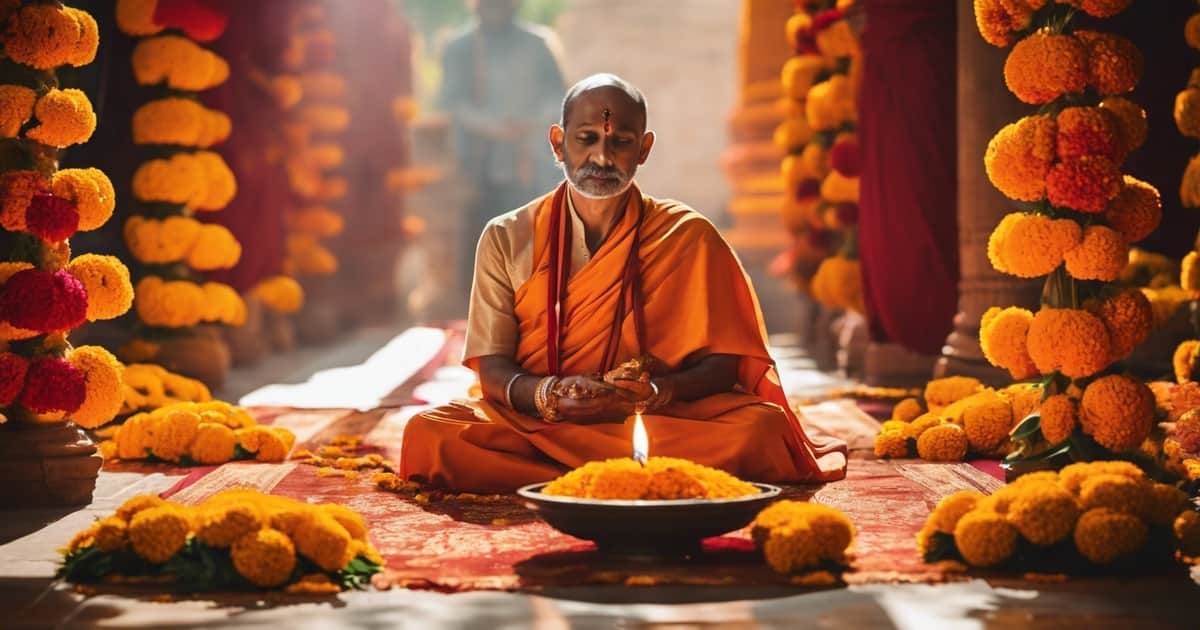Contents
- 1 Key Takeaway
- 2 The Significance of Samskaras in Hinduism
- 3 Overview of the Samskaras and Life Cycle Rites
- 4 Samskara Transformative Potential
- 5 Samskaras as Sacraments: Uniting the Material and Spiritual
- 6 Recognizing and Reconciling Negative Habit Patterns
- 7 Tools for Navigating Daily Life Through Samskaras
- 8 Samskaras Beyond Hinduism: Insights from Sikhism and Jainism
- 9 Conclusion
- 10 Frequently Asked Questions
Key Takeaway
Samskaras are mental imprints accumulated throughout life that affect behavior, thoughts, and emotions. They are a basis for karma theory in Hindu philosophy and shape an individual’s personality. The origin of samskaras can be traced back to the Vedas of Hinduism, one of the world’s oldest religious texts.
Delving into the profound concept of saṃskara within Hinduism, I’ll unravel how these pivotal elements, rooted in ancient Sanskrit texts and echoed in Vedic hymns, serve as the building blocks for moral and spiritual development.
Saṃskaras in Hinduism are not merely rituals accompanied by Vedic hymns; they’re milestones like vidyarambha, the beginning of learning, or karnavedha, the ear-piercing ceremony, that contribute to shaping one’s identity from birth through adulthood, as outlined in the Veda.
The word samskara originates from the Sanskrit words sam, meaning complete or joined together, and kara, meaning action, cause, or doing.
The Significance of Samskaras in Hinduism
Samskaras are essential for one’s spiritual journey in Hinduism. They intertwine with dharma and karma, influencing our life path, beliefs, perceptions, and even hidden expectations.
Spiritual Growth Catalyst
Samskaras are rituals that mark progress on the spiritual path in Hinduism. They help people understand their purpose, and each rite of passage has deep meaning.
Participating in ancient Sanskrit samskaras has always been a time of reflection and connection to yoga philosophy for me.
Dharma Connection
Duty, or dharma, is central to Hindu living. Samskaras, rooted in Vedic Sanskrit traditions of Hinduism, reinforce this duty by setting expectations for demeanor and responsibility at each life stage through ritual practices.
Karma Consequences
Ignoring samskaras can have negative effects on karma.
It’s believed in Hinduism that skipping important Sanskrit samskaras, as prescribed in the Veda, can result in missed opportunities for karmic progress through ritual practice.

Overview of the Samskaras and Life Cycle Rites
Samskaras highlights significant moments from birth to death. These ceremonies encompass ritual practices such as marriage and symbolize the core samskaras of life’s passage.
Birth to Childhood
The journey begins with the Garbhadhana, a Sanskrit ritual performed within Hinduism for conception, honoring old samskaras.
This baby-related Sanskrit ritual, Pumsavana, is performed in Hinduism during the third month of pregnancy to ensure good health for the mother and child in the ceremony. During the fifth month of pregnancy, the Hindu Sanskrit baby ceremony, Simantonnayana, is observed, where prayers are offered for a safe delivery.
After birth, Jatakarma welcomes the newborn into the family. The Namakarana ceremony, rooted in Hinduism, bestows a Sanskrit name upon the baby on the eleventh day. The first feeding of solid food, a ceremony known as Annaprashana in Sanskrit, is celebrated through a Hindu ritual.
Want to see a cute Annaprashan ceremony? Check out baby Pransi’s!
Education Begins
At about five years old, children undergo Upanayana. It signifies their readiness to receive education and knowledge. This ceremony introduces them to their spiritual guide or guru, marking a passage in their Hinduism journey, often accompanied by Sanskrit chants.
Marriage Ceremony
Vivaha is one of the most important samskaras. The ceremony marks the passage of two individuals into a union, taking a vow for life and honoring the ritual of partnership and life’s rites.
Later Life Rites
The Vanaprastha ceremony celebrates the passage from worldly duties to a focus on spirituality, often coming after the rites associated with having and raising a baby. The ritual of a child’s passage from baby to youth is a time for reflection and learning.
Renunciation Stage
Sannyasa is when one renounces material life completely. It’s a commitment to live solely for spiritual growth. It is the fruition of a human being’s desire for freedom and alignment with the energy of nature.
Samskara Transformative Potential
Samskaras impact how we think and act.
We can change our samskaras consciously. By recognizing harmful patterns, we can alter them for the better, transforming them into a ritual of self-improvement, a rite of passage guided by enlightened texts.
I witnessed this transformative rite firsthand when I decided to replace my procrastination habit with the proactive planning ritual, marking a passage in my personal development.
Samskaras as Sacraments: Uniting the Material and Spiritual
Samskaras act as connectors, linking our physical world to a deeper spirituality. They mark life’s milestones and shape individuals through rituals.
Beyond personal spirituality, sanskaras maintain societal order. They reinforce roles and responsibilities within communities, ensuring everyone knows their place and duties.
Recognizing and Reconciling Negative Habit Patterns
Samskaras influence how we think and act. Identifying and correcting negative passages is crucial for personal growth.
Identify Detrimental Samskaras
Every person has patterns of behavior. Some can hold us back. These are negative samskaras, or habit patterns, that we need to spot and navigate in ourselves as a passage to personal growth.
They often work on a subconscious level, shaping our actions and guiding our passage through life without us realizing it.
Methods for Rectification
Once we see these patterns, change can begin. Self-awareness is the first step towards rectifying them. This passage means paying attention to our daily habits and behaviors.
We must ask ourselves hard questions about the passage of our actions and why we do what we do. Then, actively replace negative patterns with positive ones. This passage could involve setting new goals or finding healthier ways to cope with stress.
Continuous Self-Improvement
Hindu philosophy values self-improvement highly.
Making small changes every day leads to significant improvements over time. For example, by simply starting my day earlier, I’ve been able to create a more productive morning routine that sets a positive tone for the rest of my activities.

In the previous section, we explored how to identify negative habit patterns. Now, let’s focus on developing positive samskaras to improve our daily lives.
Positive Practices for Well-Being
Positive samskaras are like seeds that grow into healthy habits. By incorporating old samskaras like yoga into daily life, we nurture a space of balance and peace within ourselves.
I find that starting my day with sun salutations not only energizes my body but also clears my mind, preparing me to face the challenges ahead with grace.
Rituals for Good Habits
Rituals provide structure to our lives. They give meaning to our actions and remind us to maintain positive habits and thoughts throughout the day. We internalize these rituals as part of our identity by consistently practicing them.
Enhanced Decision-Making
When we adhere to certain samskaras, it helps us to improve our decision-making abilities. When we face choices, practicing self-restraint through tapas can guide us toward making decisions that are truly beneficial rather than selecting something that may be appealing at the moment.
Our focus on the parallel inner worlds of anatomy, psychology, and spirit, where the roots of samskaras lie, is facilitated by vidya (awareness or seeing clearly). This clarity comes from inner strength built through regular adherence to constructive routines and thought patterns.
Samskaras Beyond Hinduism: Insights from Sikhism and Jainism
Samskaras shape our moral landscape. They influence how we think, act, and live.
Sikhism’s Samskara Perspective
Sikh teachings view samskaras differently than Hindu traditions. In Sikhism, the focus is on actions and intentions rather than rituals. The Guru Granth Sahib, Sikhism’s holy scripture, suggests that true samskaras are internalized through virtuous living and devotion to God.

Shri Guru Granth Sahib, Vol. 1 of 4: Formatted For Educational Interest (Forgotten Books)
See latest priceJain Philosophy on Samskaras
Jainism interprets samskaras with an emphasis on non-violence (ahimsa) and detachment (aparigraha). Ancient Sanskrit texts from the Jain tradition highlight the importance of purifying one’s soul to remove karmic bonds. This purification comes from ethical living and self-discipline.
Common Moral Imprints
Despite their different approaches, these religions share common views on moral imprints. They all value truthfulness, compassion, and self-control as key virtues shaping one’s life path.
Conclusion
Samskaras are not just Hindu sacraments; they extend into Sikhism and Jainism, offering universal insights into personal growth and communal harmony.
My journey through these sacred traditions underscores their potential to transform negative habits and guide daily living. I encourage you to delve deeper into your own samskaras or life rituals, recognizing their power to shape identity and purpose.
Embrace these practices with mindfulness, and consider how they might enrich your path towards self-awareness and societal contribution.
Frequently Asked Questions
What is an example of a samskara?
A common example of a samskara is the ‘Upanayana’ ceremony, which marks the beginning of formal education for young Hindu boys.
How do you break samskaras?
Breaking samskaras involves self-awareness, consistent practice of mindfulness or meditation, and sometimes guidance from a spiritual teacher to alter deep-seated patterns.
What is the difference between karma and samskara?
Karma refers to actions and their consequences, while samskaras denote mental impressions formed by past experiences and memories that affect future responses and patterns.
What are the 16 sanskaras?
The 16 sanskaras are Hindu rites of passage that begin with conception (Garbhadhana) and end with funeral rites (Antyeshti), marking key life events.
What is the meaning of sanskara?
Sanskara means ‘impression’ or ‘ritual’ in Hindu philosophy, referring to psychological patterns from past experiences or prescribed ceremonies marking life stages.







